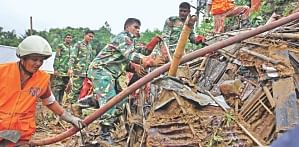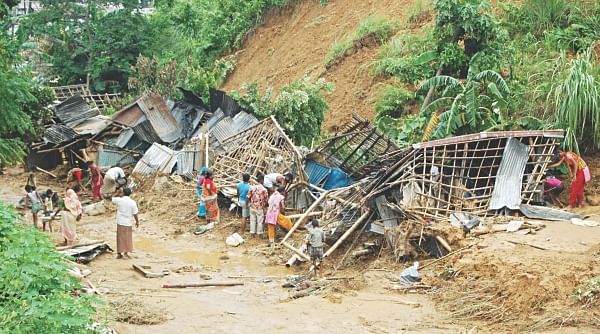| Home - Back Issues - The Team - Contact Us |
 |
| Volume 11 |Issue 27| July 07, 2012 | |
|
|
Environment Digging Our Own Graves Unplanned relocation and settlements played a crucial role in creating the tragedy that claimed the lives of 114 people in Chittgong in the recent landslide in the last week of June Tamanna Khan
'Death Toll Rises to 114' is already a forgotten news headline just as the 127 deaths in June 2007. But we cannot dismiss the disastrous landslide that took place in Chittagong as a one-off environmental disaster. Unfortunately, in a country that experiences much bigger natural calamities like Aila and Sidr, landslide grabs little attention. However, unlike cyclones, landslides caused by heavy rainfall could actually have been prevented. In fact, architect Iqbal Habib, member secretary of Bangladesh Poribesh Andolon's urbanisation and governance committee refuses to view the Chittagong landslides as a natural disaster. Habib, who has worked on the Asian University for Women's project in Chittagong, says that unlike that of other hills or steep lands, the hillside soil retention of the Chittagong hills is tricky. “While working, we found that the hills can exist indefinitely only if they are undisturbed and vegetation cover remains on top.” Made of flaky soils, the Chittagong hills are vulnerable to heavy rainfall if their surface is not covered with vegetation. “Disturbance in contour or exposing to direct angular rain drops could cause water seepage inside to create landslides,” he explains. Habib blames the government's resettling plan of the 80s for creating the disaster. At that time, plain land people, not accustomed to living in hilly areas, were settled in the Chittagong region. Habib asserts that one of the first instincts of plain land people is to clear the vegetation and cut down trees to build a house. “Then they progress to build a courtyard thus leveling the land to construct the base of their house. In that process they end up cutting hills and destroying its unique natural characteristics,” he says. Citing the indigenous population of the Chittagong Hill Tracts, he claims that they never become victims of landslide, because they live on the hills using a 'touch the earth lightly' method. “They build their houses on stilted structures,” he informs. Environmental activist Pavel Partho also places a similar argument that the traditional knowledge of the indigenous population protects them from disasters such as landslide. “They understand the eco-system of the hill and they can effectively carry out hill management,” he says. Partho explains how the stilted structure of indigenous houses does not disturb hill surface and vegetation and forest covering. Partho further notes that both the landslide tragedies of June 2007 and 2012 have taken place mainly in the urban areas of Chittagong, Cox's Bazar and Bandarban, where the hillocks are subjected to illegal cutting. He adds that although hill cutting takes place in Sylhet too, landslides are rare because Sylhet hills have a higher composition of clay than the sandy hills of Chittagong. “Besides if a hill is cut down at an angle higher than 45 degrees then it becomes vulnerable to landslides. Whereas the hills of Chittagong are being cut down at a 90 degree angle or more, landslide becomes a certainty,” he asserts.
Identifying hill cutting as one of the many factors that triggers landslide, Zafar Alam, Director of the Department of Environment (DoE), Chittagong, says that preventing the practice is the responsibility of the owner of the hill. “Hill cutting is considered as a very profitable venture. There are both private and government-owned hills. Government hills are owned by district administration or the forest department. If these hills are not monitored by the concerned departments, then first of all people earn profit by selling earth and then in the empty space created, they build houses. And this continues if there is no one to look into the matter.” He adds that owners can file cases for illegal hill cutting both under the Bangladesh Environment Conservation Act, 1995 as well as under the Penal Code as a case of theft. According to Alam, if everyone carried out their respective responsibility, hill cutting could have been stopped. “Instead, they keep on waiting for the Department of Environment and the hill cutting goes unabated,” adds Alam. Referring to the lack of resource and manpower of the department, he mentions how the State Acquisition and Tenancy Act further restricts DoE's power. Hill ownership, which falls under this law, gives owners the right to use the land in any manner s/he wants. Calling the law contradictory, Alam says, “This is very dangerous. We have repeatedly pointed out that this should be changed.” Alam adds that rainfall exceeding 400 mm acts as an indicator for the disaster. Although people are warned about the dangers of living along the slope, they do not want to re-locate. “We even did miking (public announcements) predicting the landslide in the morning of that day (June 26). In many areas, local women came with scythes to attack us. They asked us where they would go,” Alam recounts his experience of trying to save the victims of landslide. “There is a shortage of plain land in Chittagong and those who want to live at lower costs, go and build houses at the foot of the hills,” Alam says. Alam, who was a member secretary of the Divisional Hill Management Committee (HMC) formed in 2007, after the June tragedy, informs that a project was taken up and some land of Bangladesh Railway was acquired in Janali Haat. “It was said back then that this was not a wise proposition and the government could not bear the relocating cost. Nothing progressed after that. At present, the committee under the District Commissioner does not have the capacity and financial resource to carry out this task.” However, relocation without making arrangements for proper livelihood is not a solution, opines engineer Ali Ashraf, chairman of Bangladesh Institute of Planners, Chittagong Chapter. He says that the displaced people from areas like Bhola, Bhatia come to Chittagong for work and tend to live within a mile of their workplace to save transportation costs. “Housing and Settlement Authority had given small plots to low-income people in Kaibalya Dham. But now poor people cannot be found there. The rich people have bought the lands from the poor,” he informs, saying that poor people tend to view cash as more essential than land. As an alternative solution, Ashraf suggests that organisations like Bangladesh Railway or Chittagong City Corporation can build six-storied buildings with low facility dormitories of about 150 square feet in their unused lands and rent them to displaced low-income people. He stresses that the quarters should be less comfortable, so that the poor people will try to move out to more comfortable places once they can afford it. When land shortage and increasing population is a reality, a solution to cohabit peacefully with nature becomes a must. However, Iqbal Habib opines that, unlike indigenous people of the hills, plain land people will not be able to learn hill science and management overnight. In the same light, Zafar Alam says that trying to teach hill management and science to plain land people will only create an excuse to invade more hills for habitation. According to architect and urban planner Zarina Hossain, who was part of the consulting team that worked at drawing the Detailed Area Plan and Master Plan of Chittagong city, there is no short-term solution to the present problem as the human settlements in Chittagong have not been done in a planned way. She says that wire meshing is not appropriate for our hills, with soil. Landslide can only be prevented by replanting vegetation along the hillside. However that too becomes an impossible challenge in the face of growing and uncontrollable unplanned settlements, she asserts. Under the circumstances, concerned authorities should figure out long term solutions so that more lives are not lost in landslides. It is time that we design and implement plans for human settlement respecting both nature and the lives of humans.
Copyright
(R) thedailystar.net 2012 |

